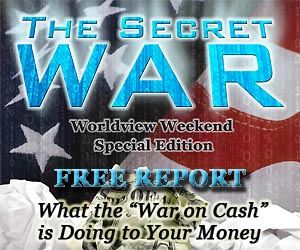In the shadow of North Korea’s ICBM test, there is growing consciousness that history has turned a page. The once hopeful post-Cold War world supposedly heralding The End of History has become a New Cold War and what some call a New Nuclear Age, wherein nuclear weapons are again the most powerful instruments of diplomacy and war.
Naïve questing for a world without nuclear weapons has catastrophically failed. Russia, China, North Korea, Pakistan, India, and probably Iran are advancing nuclear and missile programs while the U.S. nuclear deterrent ages toward obsolescence.
The world wars, Korean War, and the Cuban missile crisis are ancient history, or someone else’s history, to a new generation of political and military leaders in nuclear nations hostile to the U.S., who make nuclear threats with increasing frequency.
Hiroshima, Nagasaki, and televised H-Bomb tests that made real the terror of nuclear weapons for earlier generations are a fading memory. Few scientists and generals remain who eye-witnessed The Bomb.
Dictators of the New Cold War and their scientific and military advisors know The Bomb and its effects only theoretically. This may partially account for why they are ever bolder in nuclear blackmail, and appear to be convincing themselves that The Bomb is just another weapon.
The new crop of totalitarian and authoritarian rulers and their general staffs are also risk takers. They might benefit from witnessing an H-Bomb test, from personally seeing the blinding flash, feeling the blast and heat, cowering beneath the towering mushroom cloud.
Such an experience might even give pause to the likes of Kim Jong-un about invoking the nuclear demon.
The new crop of U.S. political-military leaders, and our nuclear-armed allies in Britain and France, need to re-learn the now forgotten nuclear lessons of the Cold War. Nuclear weapons will not deter if they are invisible.
The U.S. and its allies have been in pursuit of a world without nuclear weapons for so long, they have neglected their nuclear capabilities and given such low priority to the nuclear mission for so long, that our nuclear deterrents are almost non-existent psychologically.
Modernizing our nuclear capabilities may not strengthen deterrence if it is done reluctantly, with such fear and loathing, that our enemies think we are almost as afraid of our own nuclear weapons as of theirs.
Another lesson from the Cold War and afterwards that the U.S. and its allies need to learn is that our potential adversaries do not agree that nuclear non-proliferation is in everyone’s interests — a universal good. The hard lessons of history have proven this nostrum false.
Nations that followed our advice and gave up their nuclear weapons — like Ukraine, Libya, Kazakhstan, and South Africa — now fear for their existence or matter little in global affairs. Indeed, Libya’s Muammar Qaddaffi and Iraq’s Saddam Hussein are dead because they failed to develop nuclear arms.
Surely, Syria’s endangered dictator Bashar al-Assad must wish today he had succeeded in building The Bomb.
In contrast, failed states like North Korea, Iran, and Pakistan loom large in global affairs, have power and influence far out of proportion to their actual economic and military capabilities, because they have or could acquire nuclear weapons.
Yet another lesson from the Cold War and afterwards is that reducing the number of U.S. nuclear weapons does not necessarily make the American people or our allies safer.
Under the Strategic Arms Reduction Treaties (START) the United States reduced strategic nuclear weapons by over 90%, from 15,000 to fewer than 1,500. These reductions were unnecessary for the U.S., but were necessary for Moscow, whose economy, ruined by Cold War competition, could no longer sustain the nuclear arms race.
START was a gift from Washington to Moscow enabling Russia to maintain parity in the strategic nuclear balance. The U.S. also unilaterally dismantled nearly all of its tactical nuclear weapons, once numbering 15,000 now reduced to 180.
Now Russia is cheating on START having deployed 1,700 strategic warheads, hundreds more than permitted, and keeps building. Moscow also has at least 3,000-8,000 tactical nuclear weapons, giving it an enormous advantage in the overall nuclear balance favoring Russia by perhaps more than 5-to-1.
Russia never enjoyed such advantage during the Cold War, which may account for Moscow’s increasing belligerence toward NATO and the U.S. today.
Deep reductions in U.S. nuclear weapons has also made it possible for China to catch-up or surpass the United States.
Reducing U.S. strategic bomber bases from dozens to 3 makes it possible for even North Korea to dream of delivering a crippling nuclear blow. Kim Jong-Un’s fantasy of annihilating the United States could become reality if nothing is done to protect the nation against electromagnetic pulse (EMP) attack—deliverable by a single warhead.
If the U.S. had maintained its Cold War deterrent of nearly 30,000 strategic and tactical nuclear weapons, today the U.S. would enjoy overwhelming superiority in the nuclear balance against any combination of challengers. If this were today’s reality, would the American people be worse off?
The U.S. must ignore the usual hysterical protests from anti-nuclear activists and modernize its aged, nearly obsolete, nuclear deterrent. Peace through Strength.
Dr. Peter Vincent Pry is executive director of the Task Force on National and Homeland Security. He served in the Congressional EMP Commission, the Congressional Strategic Posture Commission, the House Armed Services Committee, and the CIA. He is author of "Blackout Wars."
Trending Stories
Latest
WE'RE A 100% LISTENER SUPPORTED NETWORK
3 Simple Ways to Support WVW Foundation
Make Monthly Donations
-or-
A One-Time Donation
-
Mail In Your Donation
Worldview Weekend Foundation
PO BOX 1690
Collierville, TN, 38027 USA -
Donate by Phone
901-825-0652













